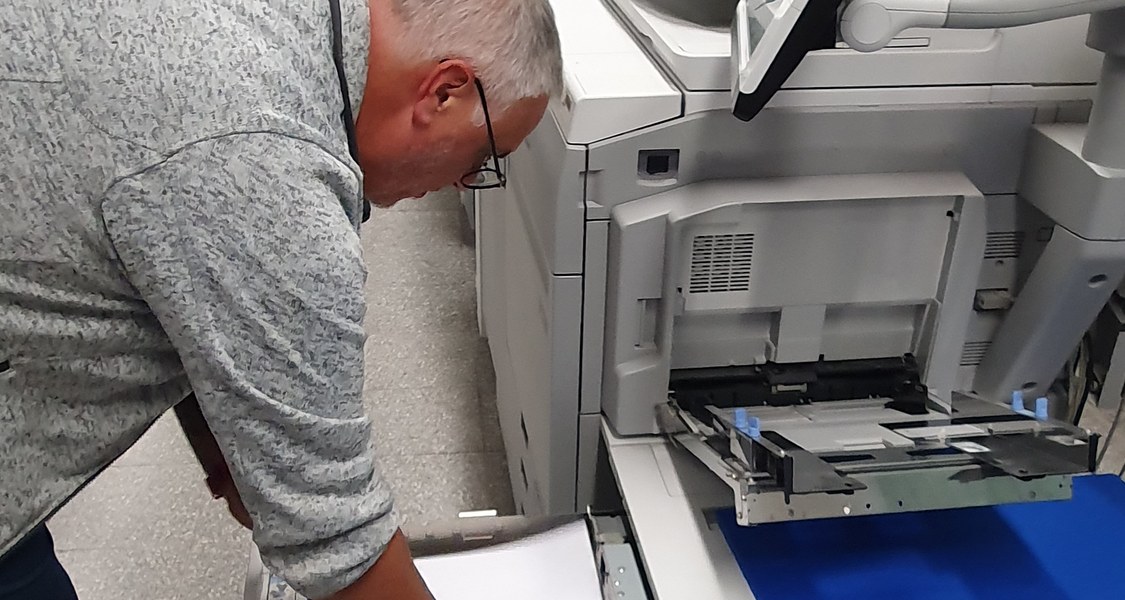07.11.2025 Neue Auflage
Die Tage der Hausdruckerei an der Uni Marburg schienen fast schon gezählt – jetzt druckt sie wieder Flyer, Klausuren, Broschüren. Ein Ortstermin

English version below: New edition
Eine halbe Stunde, und schon ist die Druckerei zur Hälfte ausgeräumt, das geht ruckzuck. Gerade standen da noch die Teile einer Schwarzweiß-Druckmaschine. Jetzt kommen zwei Mann im blauen T-Shirt und rollen eine erste Komponente hinaus, die nicht mehr gebraucht wird.
Dirk Schmack erzählt gerade von seinen Anfängen an der Uni, nun bespricht er sich mit den Männern der Spedition. Es ist früher Vormittag, Schmack ist da schon seit drei Stunden bei der Arbeit. Soeben mahnt eine elektronische Anzeige, dass die Druckmaschine Papiernachschub benötigt. „Dann kriegt sie den auch“, sagt Schmack, zieht eine Schublade am Gerät auf und legt einen Stapel weißer Bögen ein.
Klausuren, Plakate, Broschüren, ab und zu sogar ein Buch, all das kann in der Hausdruckerei der Uni produziert werden. Der Computer zeigt drei Dutzend offener Aufträge. Die große Maschine im Hauptraum spuckt fertig geheftete Klausuren aus, daneben steht eine Komponente, die zeitgleich Broschüren produziert. „Damit habe ich wenig Arbeit“, erklärt Schmack.
Anders sieht es mit Klebebindungen aus, da muss er alle Exemplare einer Auflage einzeln in die Maschine einlegen. Derzeit läuft die Druckerei als Ein-Mann-Betrieb. „Mit den richtigen Geräten schaffe ich das alleine.“
Dirk Schmack hat Buch- und Offsetdrucker gelernt, im Jahr 1994 kam er an die Uni. „Ich habe wunderschöne Zeiten erlebt“, schwärmt er. Damals arbeiteten drei Vollzeitkräfte in der Hausdruckerei. „Das Drucken war damals noch viel Handarbeit“, erzählt Schmack. „Heute läuft vieles digital.“
Das hat Folgen: Schon seit der Jahrtausendwende ging das Druckvolumen zurück. Im damaligen Uni-Kanzler keimte die Idee, den Betrieb schleichend auslaufen zu lassen. „Es war frustrierend, hingehalten zu werden“, erinnert sich Schmack. In diese Zeit fielen auch langfristige Ausfälle von Vollzeitkräften. Die Druckerei kam mit der Arbeit nicht hinterher, immer öfter vergab die Uni Aufträge nach außen.
Mittlerweile gibt es einen Plan für den Weiterbetrieb der Hausdruckerei, sogar mit mehr Personal. Der Personalrat hat sich für den Erhalt stark gemacht, um Service, Beratung und Flexibilität zu sichern.
Zwei weitere Arbeiter tauchen auf, sie holen die übrigen Geräte ab. Auf der freien Fläche könnte die Falzmaschine Platz finden, meint Schmack, den Nebenraum könnte die Druckerei dann abgeben.
Ein reiner Bürojob wäre nichts für den Drucker. „Ich sitze auch mal am Computer“, erzählt er, „aber nicht acht Stunden lang.“ Der Betrieb hält ihn auf Trab. „Jetzt macht das auch wieder Spaß!“
Hausdruckerei auf der Uni-Homepage
***
New edition
The days of the in-house print shop at the University of Marburg seemed almost numbered - now it is printing flyers, exams and brochures again. A site visit
Half an hour and the print shop is already half cleared out, it's done in no time at all. The parts of a black-and-white printing machine were just standing there. Now two men in blue T-shirts come in and roll out the first component that is no longer needed.
Dirk Schmack is talking about his beginnings at university, now he's talking to the men from the haulage company. It's early morning and Schmack has already been at work for three hours. An electronic display has just reminded him that the printing press needs a paper replenishment. ‘Then it will get it,’ says Schmack, pulling open a drawer on the machine and inserting a stack of white sheets.
Exams, posters, brochures, even the occasional book can all be produced in the university's in-house print shop. The computer shows three dozen open jobs. The large machine in the main room spits out ready-stitched exams, next to it is a component that produces brochures at the same time. ‘It doesn't cost me much effort,’ explains Schmack.
It's a different story with perfect binding, where he has to feed all copies of a print run into the machine individually. The print shop is currently a one-man operation. ‘With the right equipment, I can do it on my own.’
Dirk Schmack trained as a book and offset printer and joined the university in 1994. ‘I had wonderful times,’ he enthuses. Back then, three full-time employees worked in the in-house print shop. ‘Printing was still a lot of manual work back then,’ Schmack explains. ‘Today, a lot of it is digital.’
That has consequences: Since the turn of the millennium, the volume of printing has declined. The university chancellor at the time harboured the idea of gradually phasing out the business. ‘It was frustrating to be put off,’ Schmack recalls. During this time, there were also long-term absences of full-time employees. The print shop couldn't keep up with the work and the university was increasingly outsourcing jobs.
There is now a plan for the continued operation of the in-house print shop, even with more staff. The staff council has campaigned in favour of retaining it in order to ensure service, advice and flexibility.
Two more workers turn up to collect the remaining equipment. The folding machine could be installed in the free space, says Schmack, and the print shop could then hand over the adjoining room.
A pure office job would be nothing for the printer. ‘I sit at the computer sometimes,’ he says, ‘but not for eight hours.’ The business keeps him on his toes. ‘Now it's fun again!’
In-house print shop on the university homepage (in German)